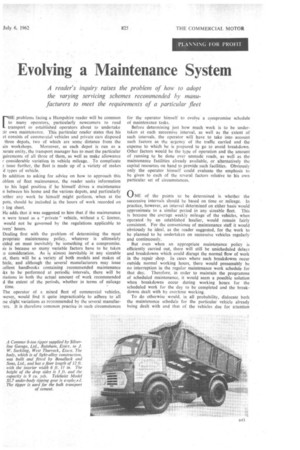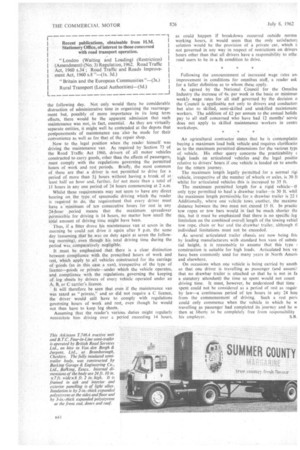Evolving a Maintenance System
Page 77

Page 78

If you've noticed an error in this article please click here to report it so we can fix it.
A reader's inquiry raises the problem of how to adopt the varying servicing schemes recommended by manufacturers to meet the requirements of a particular fleet IHE problems facing a Hampshire reader will be common to many operators, particularly newcomers to road transport or established operators about to undertake eir own maintenance. This particular reader states that his et consists of commercial vehicles and private cars disposed three depots, two of which are some distance from the sin workshops. Moreover, as each depot is run as a 3arate entity, the transport manager has to meet the particular auirements of all three of them, as well as make allowance r considerable variation in vehicle mileage. To complicate e. issue further, the fleet is made up of .a variety of makes
d types of vehicle.
In addition to asking for advice on how to approach this oblem of fleet maintenance, the reader seeks information to his legal position if he himself drives a maintenance n between his home and the various depots, and particularly iether any work he himself might perform, .when at the pots, should be included in the hours of work recorded on e log sheet.
He adds that it was suggested to him that if the maintenance n were taxed as a " private" vehicle, without a C licence, would not be governed by the regulations applicable to 'Wets' hours.
Dealing first with the problem of determining the most propriate maintenance policy, whatever is ultimately cided on must inevitably be something of a compromise. is is because so many variable factors have to be taken .o consideration. As is almost inevitable in any sizeable et, there will be a variety of both models and makes of hick, and although the several manufacturers may issue cellent handbooks containing recommended maintenance ;ks to be performed at periodic intervals, there will be nations in both the actual amount of work recommended d the extent of the periods, whether in terms of mileage time.
The operator of a mixed fleet of, commercial vehicles, wever, would find it quite impracticable to adhere to 'all ese slight variations as recommended by the several manufac-ers. It is therefore common practice in such circumstances for the operator himself to evolve a compromise schedule of maintenance tasks.
Before determining just how much work is to be undertaken at each successive interval, as well as the extent of such intervals, the operator will have to take into accotint such factors as the urgency of the traffic carried and the expense to which he is prepared to go to avoid breakdown. Other factors would be the type of operation and the amount of running to be done over unmade roads, as well as the maintenance facilities already available, or alternatively the capital resources on hand to provide such facilities. Obviously only the operator himself could evaluate the emphasis to be given to each of the several factors relative to his own particular set of circumstances.
0 NE of the points to be determined is whether the successive intervals should be based on time or mileage. In practice, however, an interval determined on either basis would approximate to a similar period in any sizeable fleet. This is because the average weekly mileage of the vehicles, when operated by an established haulier, would remain fairly consistent. For the convenience of maintenance staff it would obviously be ideal, as the reader suggested, for the work to be planned to be undertaken on successive vehicles regularly and continuously.
But even when an appropriate maintenance policy is efficiently carried out, there will still be unscheduled delays and breakdowns which could disrupt the normal flow of work in the repair shop. In cases where such breakdowns occur outside normal working hours, there would presumably be no interruption in the regular maintenance work schedule for that day. Therefore, in order to maintain the programme of scheduled maintenance, it would seem a possible solution when breakdowns occur during working hours for the scheduled work for the day to be completed and the breakdowns dealt with by overtime working.
To do otherwise would, in all probability, dislocate both the maintenance schedule for the particular vehicle already being dealt with and that of the vehicles due for attention
the following day. Not only would there be considerable distraction of administrative time in organizing the rearrangement but, possibly of more importance in its long term effects, there would be the apparent admission that such maintenance was not, in fact, essential. As they are virtually separate entities, it might well be contended at the depots that postponements of maintenance can also be made for their convenience as well as for that of the repair shop.
Now to the legal position when the reader himself was driving the maintenance van. As required by Section 73 of the Road Traffic Act 1960, drivers of all motor vehicles constructed to carry goods, other than the effects of passengers, must comply with the regulations governing the permitted hours of work and rest periods. Briefly, the most common of these are that a driver is not permitted to drive for a period of more than 5i hours without having a break of at least half an hour and, further, fot. not more than a total of 11 hours in any one period of 24 hours commencing at 2 a.m.
Whilst these requirements may not seem to have any direct bearing on the type of spasmodic driving which the reader is required to do, the requirethent that every driver must have a minimum of ten consecutive hours for rest in any 24-hour period means that the maximum spreadover permissible for driving is 14 hours, no matter how small the total amount of driving time might have been.
Thus, if a fitter drove his maintenance van at seven in the morning he could not drive it again after 9 p.m. the same day (assuming that he was on duty again at seven the following morning), even though his total driving time during the period was comparatively negligible.
It must be emphasized that there is a clear distinction between compliance • with the prescribed hours of work and rest, which apply to all vehicles constructed for the carriage of goods (as in this case a van), irrespective of the type of licence—goods or private—under which the vehicle operates, and compliance with the regulations governing the keeping of log sheets by drivers of every vehicle operated under an A, B, or C carrier's licence.
It will therefore be seen that even if the maintenance van was taxed as "private," and so did not require a C licence, the driver would still have to comply with regulations governing hours of .work and rest, even though he would not then have to keep log sheets.
Assuming that the reader's various duties might regularly necessitate him driving over a period exceeding 14 hours, as could happen if breakdown occurred outside .norma working hours, it would seem that the only satisfactor3 solution would be the provision of a private car, which i! not governed in arty way in respect of restrictions on drivers hours other than that all drivers have a responsibility to othe. road users to be in a fit condition to drive.
Following the announcement of increased wage rates an improvement in conditions for omnibus staff, a reader ask for a fuller definition as to whom these apply.
As agreed by the National Council for the Omnibu Industry the increase of 6s: per week in the basic or minimun weekly wage rates for all staff governed by the decision o the Council is applicable not only to drivers and conductor' but also to skilled, semi-skilled and unskilled maintenanc workers. The addition of £2 per annum to the annual holida pay to all staff concerned who have had 12 months' servic does not apply to skilled maintenance workers in centQ workshops.
An agricultural contractor states that he fs contemplatin buying a maximum load bulk vehicle and requires clarificatio as to the maximum permitted dimensions for the various typt of vehicle. His other query concerns the practicability c high loads on articulated vehicles and the legal positio relative to drivers' hours if one vehicle is loaded on to anotht for the return journey.
The maximum length legally permitted for a normal rigi vehicle, irrespective of the number of wheels or axles, is 30 ft whilst for articulated vehicles this is increased to 35 ft.
The maximum permitted length for a rigid vehicle—ti' only type permitted to haul a drawbar trailer—is 30 ft. whil the maximum length permissible for a drawbar trailer is 22 Additionally, where one vehicle tows another, the maximu distance between the two must not exceed 15 ft. In practic tow ropes or tow bars would in fact be much shorter tho this, but it must be emphasized that there is no specific leg limitation on the combined overall length of the towing vehiel tow rope, chain or bar and the ..drawbar trailer, although ti individual limitations must not be exceeded.
As several articulated trailer chassis are now being fin( by leading manufacturers with standard box vans of substa tial height, it is reasonable to assume that this type construction is suitable for high loads. Articulated box vat have been commonly used for many years in North Amerii and elsewhere.
On occasions when one vehicle is being carried by anoth so that one driver is travelling as passenger (and assumi: that no drawbar trailer is attached so that he is not in fa a statutory attendant) the time so spent would not count driving time. It must, however, be understood that time . spent could not be considered as a period of rest as requir by law—a continuous period of ten hours in any 24 hou from the commencement of driving. Such a rest perit could only commence when the vehicle in which he w travelling as passenger had completed its journey and he w then at liberty to be completely free from responsibility his employer. S.B.




















































































































